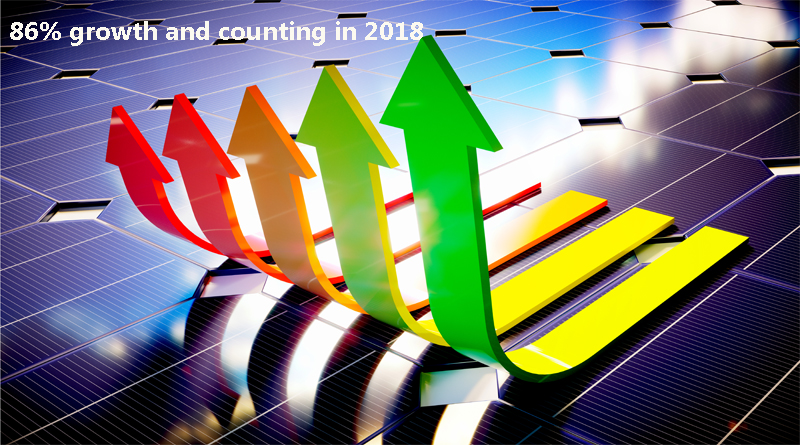

Solar generation is the big winner from India’s ambitious push for renewable energy, leading to a massive growth of 86% in actual solar power generation in the first half of 2018, as compared to the corresponding period last year.
According to the data issued by the Central Electricity Authority (CEA), solar power generation in the second quarter of the year 2018 increased by almost 73 percent year-over-year (YoY) to 9.5 billion units (BU) compared approximately 5.4 BU which were generated by solar projects during the same period, last year.
In the second quarter this year, the Indian solar market saw a total of nearly 1.4 GW of installations based on preliminary reports. Relatively lower than the 3.3 GW (reported) worth of Installations undertaken in the first quarter of the year. However, the installations made over the two quarters resulted in an 11 percent growth in solar energy generation quarter over quarter when compared to the first quarter of this year, which according to the data provided by CEA ended at 8.5 BU.
Thus, comparing the YoY increase in solar energy generation for the first half of the year 2018 which ended at 18.05 BUs, the resulting increase from the first half of 2017 (9.67 BUs) was a substantial 86 percent.
Going forward, expect the rate of growth to slow down, as already evident between the two quarters in H1 of this year. Roiled by import duty issues, power evacuation and plain and simple viability, it will take a special effort to ensure that the government hits its stated targets on solar power capacity and hopefully, generation.
Although these numbers paint a very pleasing picture, India’s progress in a solar still has a long way to go, to become one of the leading sources of energy generation in the country. Despite the increase in renewable capacity addition, coal-fired capacity still dominates and accounted for more than half (56.6%) of India’s total installed power capacity.
According to data available from CEA and MNRE, by the end of June 2018, India has a 24.4 GW of solar capacity installed in the country, which represents a 7.03 percent share of the total power capacity in India. The sector could grow and expand a lot faster if some of the persisting issues could be cleared by the government on time. Earlier this year, Coal India, the world’s largest coal company, admitted that it was “only a matter of time” that renewables replaced fossil fuels in the country. The development of solar power and energy storage are seen by the company as the key changes in the market. This statement was supported by the fact that of all the new energy capacity that was added to the energy grid of India in 2017, a minimum 65% of the total was through solar and wind energy projects.
Installation trends in the energy sector clearly depict the direction in which India is planning to move, but to source away from coal into renewables is still a long and arduous task.
In a significant move toward advancing green energy and industrial growth in the state, Himachal…
Golabl chemical conglomerate BASF has announced that its now offering the world’s first biomass-balanced polyethersulfone…
In a crucial stint to bolster the biogas sector and sustainable dairying in the country,…
TotalEnergies SE has received approval to proceed with its Middlebrook solar and battery project in…
Andhra Pradesh Chief Minister Chandrababu Naidu has inaugurated the Rs 1,000-crore green hydrogen plant of…
The BITS Pilani has developed an innovative solution for managing landfill leachate, domestic septage, and…